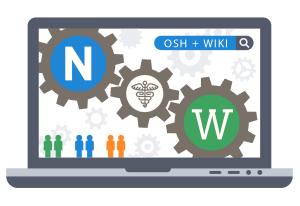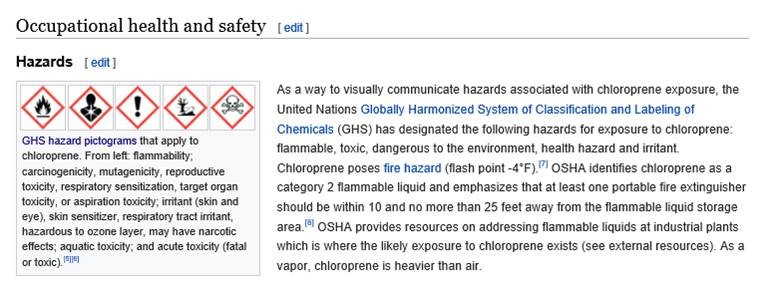NIOSH, Wiki Education Foundation, and Harvard University Work Together to Make Occupational Safety and Health Content Accessible to All
Posted on by Choosing the right final project for a graduate level course can be a daunting responsibility for any instructor. Harvard Research Scientist and Instructor Dr. Diana Ceballos heard NIOSH researcher Dr. Thais Morata share details at a NORA conference about NIOSH’s collaboration with academia and Wikipedia to teach students science translation and knew it was a perfect match. After just a few emails and quickly enrolling to use the Wiki Education Foundation platform, an incredible new way of teaching had begun.
Choosing the right final project for a graduate level course can be a daunting responsibility for any instructor. Harvard Research Scientist and Instructor Dr. Diana Ceballos heard NIOSH researcher Dr. Thais Morata share details at a NORA conference about NIOSH’s collaboration with academia and Wikipedia to teach students science translation and knew it was a perfect match. After just a few emails and quickly enrolling to use the Wiki Education Foundation platform, an incredible new way of teaching had begun.
The partnerships created between NIOSH, Wiki Education Foundation, and university programs to expand and improve occupational safety and health content in Wikipedia were introduced in an earlier NIOSH Science Blog, The Powerhouse: Students’ contributions towards expanding and improving occupational safety and health content in Wikipedia (July 30, 2018). In this blog we will give you behind-the-scenes details on the steps taken by the students, and some of the lessons learned.
Dr. Ceballos used the Wiki Education Foundation platform during two of the years she taught the graduate course EH262, Introduction to the Work Environment, at the Harvard T.H. Chan School of Public Health. During the first year, in the fall of 2017, she asked students to add or improve occupational health content to existing Wikipedia pages, as a group assignment. In the fall of 2018 Dr. Ceballos asked the students to perform individual projects. The most recent effort was highlighted in a Harvard T.H. Chan news article, “Course uses Wikipedia as tool for teaching science translation.”
The Wiki Education Foundation platform is easy to use and customize. The resources and training materials are of excellent quality, and the support provided by the staff is prompt. Instructors can continue to focus on the subject matter of their course and the principles of scientific writing, and count on the support of the Wiki Education Foundation staff to help with the mechanics of writing for Wikipedia. The involvement of NIOSH added an extra layer of support. Students who needed help to select topics to write about found plenty of suggestions at the WikiProject on Occupational Safety and Health. NIOSH staff were available to provide suggestions and additional training, and followed up with the students as needed. Their involvement gave the students a sense that their work was valued, worth their time, and needed by the community. That probably explains their enthusiasm towards the project, along with the knowledge that their article would showcase their science communication skills, which may come in handy when interacting with future employers.
Improving both Scientific and Plain English Writing
Students need to learn to reference their work appropriately and avoid plagiarism, and many of the students were confronted for the first time with scientific writing. The online training provided by the Wiki Education platform on citations was very relevant to both writing in plain language and to a scientific peer reviewed publication. It helped students understand the value of including quality references in scientific writing and the challenges of choosing unbiased supporting evidence from the health literature.
Getting Familiar with the Peer Review Process
Publishing in Wikipedia involves review and feedback by other contributors. Some of the students’ contributions were initially erased from Wikipedia because they lacked references, and later reinstated when appropriate references were cited. Some students were alerted by Wikipedia editors who found their contributions to be long and complicated. This required students to write more clearly and succinctly, which are pillars of plain English communication. The students appreciated the quick review by the Wikipedia community, even if many were initially frustrated by the feedback received.
Stylistic and technical feedback was also provided by Dr. Ceballos and by Teaching Fellow MyDzung Chu and Co-Instructor Robert Herrick to help students improve their articles within the timeline of the class. Students’ contributions to the Wikipedia articles on Isocyanate and Electronic Waste could count on the help of Dr. Ceballos’ experience on isocyanates and electronics waste recycling. This is just one example of how the instructors, along with the Wikipedia peer review process, helped articles become technically stronger.


Wikipedia as a Science Translation Teaching Tool
Students valued the opportunity to publish with the knowledge that their contributions were reaching the general public. They enjoyed choosing their own topic for their Wikipedia final class project. The resulting articles clearly showcased the students’ interests and expertise in a way that can rarely be seen within the classroom. Many of the students in the fall 2017 course were from the U.S. Air Force and contributed from their own experiences and knowledge to the Micro-g environment Wikipedia article.
All involved were very impressed by how students went beyond the assigned tasks of the course, and by the creativity, commitment, and resourcefulness that was infused into many of the projects. One student not only added content to the article on Chloroprene, but also uploaded the HAZCOM pictogram to Wikimedia Commons . This allowed the pictogram to be incorporated into the article and available for anyone to use with attribution. Another student created a brand-new Wikipedia article on Occupational health and safety in the casino industry and contributed photographs he had taken.
In conclusion, by using Wikipedia students learned the process and value of translating science to the public. The goal of learning a topic well enough to be able to write in a style accessible to lay readers is challenging, and requires more research than a traditional assignment. Finally, the articles the students worked on were viewed more than 400,000 times during the two semesters, a great highlight for both instructors and students. A list of all of the Wikipedia articles that students from this course worked on can be found here. This table links to Wikipedia articles that have been tagged as covering occupational safety and health topics, grouped by their quality and importance ratings.
We see this framework as an effective way to teach students about occupational health, scientific writing, and science translation and we are encouraged that other programs teaching students in occupational health around the country are trying this approach. The resulting Wikipedia articles are not only a great example of participatory education, but they help NIOSH realize its mission to disseminate occupational health knowledge.
We look forward to addressing any suggestion, question or comment you might want to send our way.
Diana Ceballos, PhD, MS, CIH, was a Research Scientist and Instructor when implementing this Wikipedia project at Harvard T.H. Chan School of Public Health, Department of Environmental Health. She was an Industrial Hygienist at NIOSH from 2010-2015. Currently, she is starting as an Assistant Professor at Boston University School of Public Health. She is also a member of the National Occupational Research Agenda Services Sector Council.
Thais Morata, PhD, is a researcher in the NIOSH Division of Applied Research and Technology. She is coordinator of the National Occupational Research Agenda Manufacturing Sector Council.
John P. Sadowski, PhD, is the Wikipedian-in-Residence at the National Institute for Occupational Safety and Health.
Additional Information
Expanding and Improving Occupational Safety and Health Content in Wikipedia. It Matters
Posted on by

